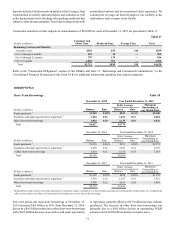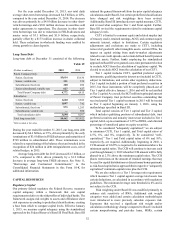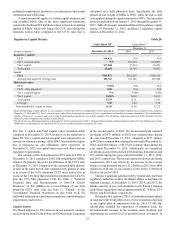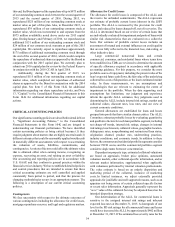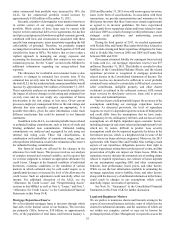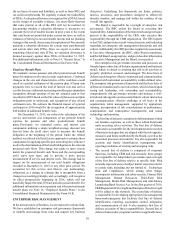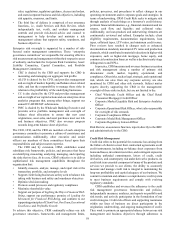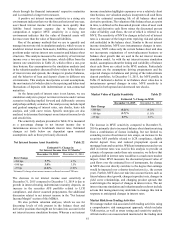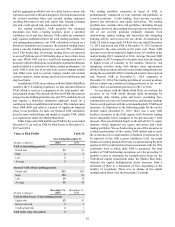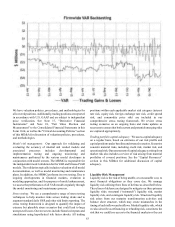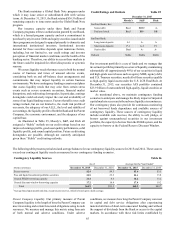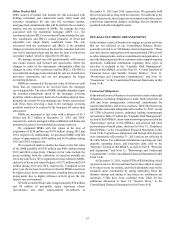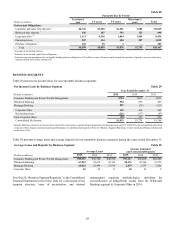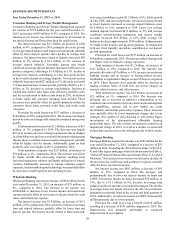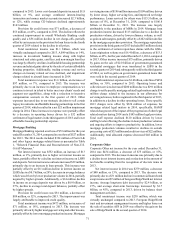SunTrust 2015 Annual Report Download - page 89
Download and view the complete annual report
Please find page 89 of the 2015 SunTrust annual report below. You can navigate through the pages in the report by either clicking on the pages listed below, or by using the keyword search tool below to find specific information within the annual report.
61
sheets through the financial instruments' respective maturities
and is considered a longer term measure.
A positive net interest income sensitivity in a rising rate
environment indicates that over the forecast horizon of one year,
asset based interest income will increase more quickly than
liability based interest expense due to balance sheet
composition. A negative MVE sensitivity in a rising rate
environment indicates that the value of financial assets will
decrease more than the value of financial liabilities.
One of the primary methods that we use to quantify and
manage interest rate risk is simulation analysis, which we use to
model net interest income from assets, liabilities, and derivative
positions under various interest rate scenarios and balance sheet
structures. This analysis measures the sensitivity of net interest
income over a two-year time horizon, which differs from the
interest rate sensitivities in Table 22, which reflect a one-year
time horizon. Key assumptions in the simulation analysis (and
in the valuation analysis discussed below) relate to the behavior
of interest rates and spreads, the changes in product balances,
and the behavior of loan and deposit clients in different rate
environments. This analysis incorporates several assumptions,
the most material of which relate to the repricing and behavioral
fluctuations of deposits with indeterminate or non-contractual
maturities.
As the future path of interest rates is not known, we use
simulation analysis to project net interest income under various
scenarios including implied forward and deliberately extreme
and perhaps unlikely scenarios. The analyses may include rapid
and gradual ramping of interest rates, rate shocks, basis risk
analysis, and yield curve twists. Specific strategies are also
analyzed to determine their impact on net interest income levels
and sensitivities.
The sensitivity analysis presented in Table 22 is measured
as a percentage change in net interest income due to
instantaneous moves in benchmark interest rates. Estimated
changes set forth below are dependent upon material
assumptions such as those previously discussed.
Net Interest Income Asset Sensitivity Table 22
Estimated % Change in
Net Interest Income Over 12 Months 1
December 31, 2015 December 31, 2014
Rate Change
+200 bps 5.7% 6.7%
+100 bps 3.0% 3.5%
-25 bps (1.2)% (1.0)%
1 Estimated % change of net interest income is reflected on a non-FTE basis.
The decrease in net interest income asset sensitivity at
December 31, 2015 compared to December 31, 2014 is due to
growth in interest-bearing indeterminate maturity deposits, an
increase in the securities AFS portfolio related to LCR
compliance, and slower assumed prepayments. See additional
discussion related to net interest income in the "Net Interest
Income/Margin" section of this MD&A.
We also perform valuation analyses, which we use for
discerning levels of risk present in the balance sheet and
derivative positions that might not be taken into account in the
net interest income simulation horizon. Whereas a net interest
income simulation highlights exposures over a relatively short
time horizon, our valuation analysis incorporates all cash flows
over the estimated remaining life of all balance sheet and
derivative positions. The valuation of the balance sheet, at a point
in time, is defined as the discounted present value of asset cash
flows and derivative cash flows minus the discounted present
value of liability cash flows, the net of which is referred to as
MVE. The sensitivity of MVE to changes in the level of interest
rates is a measure of the longer-term repricing risk and options
risk embedded in the balance sheet. Similar to the net interest
income simulation, MVE uses instantaneous changes in rates.
However, MVE values only the current balance sheet and does
not incorporate originations of new/replacement business or
balance sheet growth that are used in the net interest income
simulation model. As with the net interest income simulation
model, assumptions about the timing and variability of balance
sheet cash flows are critical in the MVE analysis. Particularly
important are the assumptions driving prepayments and the
expected changes in balances and pricing of the indeterminate
deposit portfolios. At December 31, 2015, the MVE profile in
Table 23 indicated a decline in net balance sheet value due to
instantaneous upward changes in rates. MVE sensitivity is
reported in both upward and downward rate shocks.
Market Value of Equity Sensitivity Table 23
Estimated % Change in MVE
December 31, 2015 December 31, 2014
Rate Change
+200 bps (8.2)% (4.2)%
+100 bps (3.7)% (1.5)%
-25 bps 0.7% 0.1%
The increase in MVE sensitivity compared to December 31,
2014 is primarily due to increased balance sheet duration arising
from a combination of factors including, but not limited to,
extending receive-fixed interest rate swaps, an increase in the
securities AFS portfolio related to LCR compliance, slightly
shorter deposit lives, and reduced prepayment speeds on
mortgage loans and securities. While an instantaneous and severe
shift in interest rates was used in this analysis to provide an
estimate of exposure under these rate scenarios, we believe that
a gradual shift in interest rates would have a much more modest
impact. Since MVE measures the discounted present value of
cash flows over the estimated lives of instruments, the change
in MVE does not directly correlate to the degree that earnings
would be impacted over a shorter time horizon (i.e., the current
year). Further, MVE does not take into account factors such as
future balance sheet growth, changes in product mix, changes in
yield curve relationships, and changing product spreads that
could mitigate the impact of changes in interest rates. The net
interest income simulation and valuation analyses do not include
actions that management may undertake to manage this risk in
response to anticipated changes in interest rates.
Market Risk from Trading Activities
We manage market risk associated with trading activities using
a comprehensive risk management approach, which includes
VAR metrics, as well as stress testing and sensitivity analysis.
All risk metrics are measured and monitored at the trading desk


